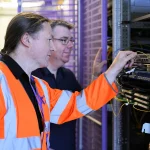Spend £5bn of Public Money on Full Fibre Broadband? Yeah No Probs
The latest online survey of 2,110 ISPreview.co.uk readers has found that 65.9% of UK respondents think spending up to £5bn of taxpayers money to ensure nationwide coverage of “full fibre” (FTTP) broadband by 2033 is a better bet than putting the same money toward public services. But most people expect a long wait.
The survey, which was conducted between 2nd January and 14th February 2019, found that most respondents do not expect to see “full fibre” FTTP broadband arrive in their area for many years and 17.4% even fear it may “NEVER” reach them.
The Government’s Future Telecoms Infrastructure Review (FTIR) proposed that nationwide availability would require public funding of up to £5bn, which could be used to support private investment in the final 10% of areas (mostly rural locations). Clearly this has some good support, even if many people doubt the currently quite aspirational time-scale.
Advertisement
How long do you think it will be before full fibre (FTTP) broadband reaches your area (pick closest)?
5-10 Years – 23.3%
2-5 Years – 18.7%
NEVER – 17.4%
10-15 Years – 17.2%
I can get it now! – 11.5%
1 Year – 5.8%
2 Years – 5.8%The UK gov may have to invest c.£5bn of taxpayers money to ensure nationwide coverage of FTTP by 2033. Do you support this cost?
Yes – 70.4%
No – 16.9%
Maybe – 12.6%Some say such funding would be better spent on hospitals or other public services. Do you agree?
No – FTTP fuels growth – 65.9%
Yes – Forget FTTP – 17.5%
Unsure – 16.5%
Deploying better broadband connectivity has in the past been shown to deliver an economic boost (example) and it’s thus hoped that investing to ensure nationwide coverage of FTTP may eventually pay for itself by fuelling more economic growth. All this could in turn help to support public services, possibly even more so than if £5bn were to simply be thrown at them as a one-off.
However we do still have our doubts about the commercial market’s ability to deliver the majority of that FTTP coverage and within the proposed time-scale. We’re also sceptical about whether ISPs would have much interest in match-funding such an effort to the final c.20-30% of premises, let alone the final 10%, particularly if the 5 year business rates holiday on new fibre isn’t extended.
The previous Broadband Delivery UK scheme largely focused upon supporting cheaper hybrid figure services (FTTC) via £1.6bn+ of public investment, although nearly half of that came from local authorities. Trying to replicate the same approach with FTTP in the future would be a lot more expensive and we suspect that local authorities may struggle to support it due to their already cash strapped budgets.
Nevertheless, full fibre is the future, but the question of delivery and investment is one that will probably only end up being answered by a different government in the future. The country is likely to go through several governments before 2033 and inevitably policies, as well as investment priorities, can change. Planning beyond a single parliamentary term is often fraught with difficulty.
Advertisement
UPDATE 7:38pm
Rural fibre optic ISP TrueSpeed, which is entirely supported by commercial investment, has sent in a comment that offers a different perspective.
Evan Wienburg, co-founder and CEO of TrueSpeed, said:
“It’s surprising to see two thirds of respondents believe that £5bn of taxpayers’ money on nationwide FTTP rollout is a better bet than putting the same money towards public services. This is especially the case when we have so many examples of national providers wasting taxpayer funds on building FTTC/FTTP networks where rollout is already complete or in progress by privately funded providers.
We wholeheartedly endorse the Government’s proposal to ensure FTTP rollout by 2033, but we should consider whether this £5bn is an effective deployment of public funds, when there’s a number of public services that don’t see the same private investment as broadband in the UK.
We found that 46% of people in the South West of England believe better broadband connectivity would be the most beneficial infrastructure development for their local economy – ahead of new rail or bus transport links – in our recent survey. While better broadband is clearly a crucial concern for many, the Government must ensure that local economies can truly thrive by ensuring public funds are invested only where private funds could not just as easily yield the same results.”
One slight problem here is that we’ve yet to see any commercial providers commit the investment needed to cover all rural areas across the UK. Some have found ways to tackle certain limited areas, but scaling this up has proven difficult (e.g. Gigaclear) and delivering at pace remains even harder.
Most other commercial providers have generally required match funding with public money in order to make it more economically viable at scale. But past a certain point even the match-funded model can begin to breakdown without ever bigger subsidies (e.g. Openreach in Wales – the Phase 2 contract).
Advertisement
Rural areas don’t want to wait another generation for full fibre connectivity to arrive and if it’s going to hit the 2033 aspiration then more public investment seems inevitable.
Mark is a professional technology writer, IT consultant and computer engineer from Dorset (England), he also founded ISPreview in 1999 and enjoys analysing the latest telecoms and broadband developments. Find me on X (Twitter), Mastodon, Facebook, BlueSky, Threads.net and Linkedin.
« Government Sets Out Strategic Priorities for UK Broadband and Mobile

















































Comments are closed